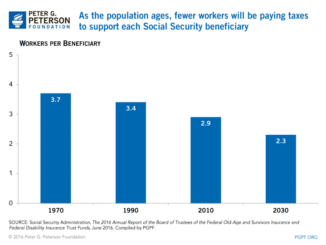
by Charles Blahous
Last month, Morgan Stanley published a research report projecting that US labor force growth will exceed Congressional Budget Office (CBO) projections starting in the 2020s, and also asserting that this faster growth “should” delay Social Security’s insolvency, “perhaps by decades.” Specifically, the report stated that “a faster increase in the pool of covered workers is an important factor in the Social Security Trustees’ ‘low cost’ scenario, which would delay the date at which the Social Security trust fund reserves could become depleted from 2034 to 2062.”
Multiple articles in MarketWatch, Yahoo, and elsewhere seized uncritically upon this tantalizing prospect, with the MarketWatch piece stating that such variance in labor force growth has “tremendous implications,” that it might help Social Security solvency last “for another generation,” and that “if Morgan Stanley is right, the Social Security trust fund reserves might become depleted in 2062,” long after the current projection of 2034.
MarketWatch’s headline statement that “higher than predicted labor force participation” might by itself plausibly sustain Social Security for several additional decades is flatly wrong. Morgan Stanley’s report should not have suggested this, news articles about the study should not have asserted it, and their respective authors should correct these misimpressions if they haven’t already.
First, some quick background. For several decades now, annual Social Security trustees’ reports have warned consistently that the program’s scheduled benefit obligations far exceed its projected revenues, and have urged lawmakers to enact financial corrections before it is too late to realistically do so. These reports have stressed that, while various economic and demographic factors cannot be projected precisely, there is nevertheless a high degree of certainty that the shortfall will not correct itself without legislative action. The idea that faster labor force growth might by itself substantially postpone the problem is sharply at odds with these repeated bipartisan messages.
Second, a brief disclaimer. I believe strongly in the benefits of increased labor force participation. Indeed, much of my own writing about Social Security policy stresses the value of reforming the program to fix work disincentives. More labor force participation is not only good for Social Security finances, it’s good for the economy as a whole, for the larger federal budget, and for workers themselves. Nothing that follows in this article should be misconstrued as failing to recognize the many benefits of faster labor force growth.
I will now review some of the several respects in which the “solvency until 2062” claim is erroneous.
Social Security’s trustees sometimes stress that its projected depletion date is an inadequate proxy for system financial health, for the simple reason that by the time the insolvency date rolls around, it is far too late to fix the problem. What matters is the size of the shortfall requiring correction, and whether there is still a reasonable chance to correct it. But even when we invoke the program’s projected insolvency date as a crude shorthand for its financial condition, it’s still clear that increased labor force participation won’t change the contours of the financial problem all that much.
A larger labor force means more wages subject to the Social Security tax, which in turn means more revenues for the program. But it also means larger benefit obligations later, deriving from the additional contributions. The additional revenues arrive first, delaying insolvency somewhat. Still, the qualitative net effects aren’t very large. A sensitivity analysis in the trustees’ report shows that even if annual national real wage growth increases over 50% faster than current projections, insolvency will be delayed by only three years, from 2034 to 2037. Note that this analysis does not focus narrowly on labor force participation, but models a wider array of factors that might conceivably lead to more taxable earnings. The bottom line is that even if increased labor force participation were to result in a dramatic acceleration of national earnings growth, it would still change Social Security’s financial picture by only very little.
So, what about that trustees’ “low-cost” projection scenario that shows Social Security’s trust funds lasting until 2062? Well, that projection has virtually nothing to do with increased labor force participation. Here are just some of the assumptions that all must pan out for that scenario to transpire:
- The US fertility rate rebounds to 2.2, permanently. For reference, the current US fertility rate is about 1.8, and the US has not had a single year exhibiting a 2.2 fertility rate since 1971.
- Annual US mortality improvements will slow down to barely half the rate of progress assumed in the primary projections. Basically, this scenario assumes that Social Security will cost less than now projected, because we’ll stop making significant progress in improving longevity, and recipients won’t collect benefits for as long.
- Immigration will be over 25% higher than now projected.
- Annual productivity growth will be over 20% higher than now projected.
- Real wages will grow more than 50% faster than now projected.
- After 2028, the US will never again see an unemployment rate above 4.5%.
- Disability incidence will drop by over 20% relative to the primary projections.
- Disability recovery rates will increase by over 20% relative to the primary projections.
If you think it highly unlikely that all of these factors will occur simultaneously, thereby delaying Social Security’s projected insolvency until 2062, you are not alone. The trustees perform an annual stochastic analysis that provides 80% and 95% confidence bands for the projections, including the insolvency date. Last year’s analysis found with 80% confidence that Social Security’s trust funds would be depleted between 2032 and 2039, and 95% confidence that depletion would occur between 2030 and 2043. In other words, there is only a 2.5% chance that the trust funds will remain solvent past 2043. The 2062 insolvency projection scenario is not remotely within the range of likely outcomes and is not intended to be. It is designed to be an illustration of the potential range of movement in the projections if, unrealistically, all relevant variables break in the same direction.
A particularly glaring error in the MarketWatch piece, though an understandable misimpression given the wording of the original Morgan Stanley report, is its failure to note that faster labor force participation growth plays virtually no role in the trustees’ 2062 projection scenario. Consider this passage from the trustees’ report (bolding added):
“More optimistic economic assumptions in the low-cost alternative are consistent with higher labor force participation rates, while demographic assumptions in the low-cost alternative (such as slower improvement in longevity) are consistent with lower labor force participation rates. These economic and demographic influences have largely offsetting effects. Therefore, the projected labor force participation rates do not vary substantially across alternatives.”
Translated, this means that there are some assumptions in the trustees’ low-cost (2062) scenario that push labor force participation up, and others that push it down. On balance, though, there isn’t significant variation in labor force participation between the trustees’ main 2034 projection and their illustrative 2062 projection.
The Morgan Stanley report itself fails to account for the net effects of these interrelated factors. The report projects higher labor force participation rates than CBO does, based on an expectation that recent “improvements in health and life expectancy” will “continue over the next couple of decades.” But if those life expectancy improvements do continue, they won’t only boost labor force participation, they will also increase Social Security expenditures, because recipients will collect benefits over longer lifetimes. This is the opposite of what is assumed in the trustees’ low-cost (2062) projection scenario, in which program expenditures are lowered by beneficiaries dying earlier.
In summary, the trustees have indeed produced an illustrative scenario in which Social Security insolvency is delayed until 2062, but a) it’s the product of an array of extremely improbable assumptions, and b) increased labor force participation has nothing to do with it. The representation that faster labor force growth might by itself plausibly delay Social Security insolvency for nearly three decades is inaccurate, and it should be corrected.
Charles Blahous is the J. Fish and Lillian F. Smith Chair and Senior Research Strategist at the Mercatus Center, a visiting fellow with the Hoover Institution, and a contributor to E21. He recently served as a public trustee for Social Security and Medicare. He thanks Brenton Smith for drawing his attention to coverage of the Morgan Stanley report.



